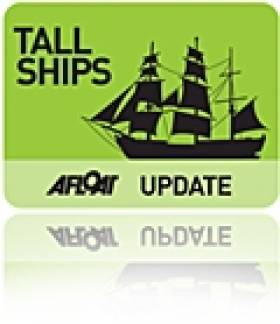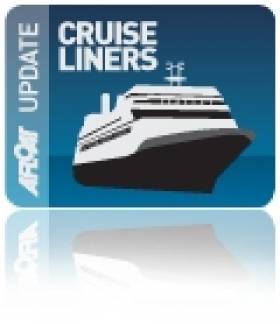Displaying items by tag: Mexican Navy Tallship Cuauchtemoc
Mexican Navy Tall Ship Sails into Dublin
#mexicantallship – Dublin Port Company and the Mexican Embassy in Dublin have welcomed one of the world's most magnificent Tall Ships, the 1,800 tonnes and 270 foot long Cuauhtémoc – that had been at anchor in Dublin Bay since Monday – sailed into Dublin city centre this morning for a five day visit to the capital.
The spectacular vessel was met by Dublin Port's tugs Shackleton and Beaufort in a ceremonial escort to mark the ship's arrival, before docking at 10am on Sir John Rogerson's Quay.
As Afloat previously reported last week the windjammer commanded by Captain Pedro Mata, the Cuauhtémoc is a sail training vessel of the Mexican Navy which travels around the world carrying a message of friendship and goodwill. She arrived in Dublin with 225 men and women sailors on board - including trainees of different nationalities - who will participate in a five-day programme of engagements in the capital as part of the 40th anniversary celebration of the establishment of diplomatic relations between Ireland and Mexico.
Highlights of the itinerary include an accompanied tour of the city for crew, a visit to the vessel by President Michael D. Higgins and his wife Sabina Higgins on Sunday, and a special performance by 'The Buena Vibra Latin Jazz Trio with the Royal Irish Academy of Music Percussion Ensemble' on board, as well as the San Patricio Mariachi Band.
Dubliners and visitors to the city hoping to get a closer insight into life on board this magnificent vessel will be able to visit for free while she is berthed at Sir John Rogerson's Quay. Opening times to the public are Wednesday 17th – Saturday 20th June between 10.00 and 19.00, and on Sunday 21st June from 10.00 to 15.00. During her last visit to Dublin as part of the Tall Ship Races 2012, the Cuauhtémoc welcomed over 23,000 visitors on board.
Built in the Celaya shipyards in Bilbao, Spain, the Cuauhtémoc was launched in July 1982. She was the last of four windjammers built by Bilbao shipyards and is named after the last Aztec emperor who was imprisoned and executed by the conquistador, Herman Cortes, in 1525. This will be her fourth visit to Irish waters.
Eamonn O'Reilly, Chief Executive of Dublin Port Company, said: "Dublin Port Company is delighted to welcome Cuauhtémoc and her entire crew to Dublin for a very special visit in a significant year for Mexican-Irish relations. Her visit serves as an important reminder of our cultural bond and trading links that have grown from strength to strength over the past 40 years. I would encourage everyone in the city to show the Cuauhtémoc a warm Irish welcome during her stay. It's a fantastic opportunity to explore this magnificent vessel up close and experience first-hand Mexican maritime culture on our doorstep."
The Ambassador of Mexico to Ireland, H.E. Carlos Garcia de Alba said: "2015 marks the 40th anniversary of the establishment of diplomatic relations between Ireland and Mexico. This important milestone in our shared history affords both Mexico and Ireland the opportunity to showcase trade, academic and investment partnerships and to share in artistic and cultural exchanges between our countries. The arrival to Dublin of the Mexican Navy's Tall Ship Cuauhtémoc is just one of the many events to take place that reaffirms the commitment to strengthen the excellent ties of friendship and co-operation between our nations."
Semester at Sea Ship Sets Sail Amid a ‘Blaze of Light’
#SEMESTER-SHIP – Last night the semester at sea cruiseship Explorer with more than 800 students, academics and crew, as previously reported on Afloat.ie, departed into Dublin Bay in a blaze of light, having visited the capital for a two-days, writes Jehan Ashmore.
It was rather unusual to see a vessel bedecked with the special display, where the lighting arrangement was strung from stem to stern along the 180m long. On board the 25,000 tonnes vessel where students from the University of Ohio, who are taking a 'semester at sea' world cruise programme operated by the not-for-profit initiative organised by the Institute for Shipboard Education in co-operation with the university.
The nightime visual spectacle, is similar to the daylight version of a ship 'dressed overall' (using the nautical flags) as perfectly demonstrated by the Tall Ships participant barque Cuauhtemoc of the Mexican Navy, as previously reported on Afloat.ie. Noting aerial video footage of her arrival to Dublin Port and featured in the accompanying Parade of Sail gallery.
As Explorer proceeded further out of Dublin Bay, and into the open sea, the special lighting display was switched off. She set a course for the Kish Bank Lighthouse and the vessel is currently off Cornwall and heading up the English Channel.






























































